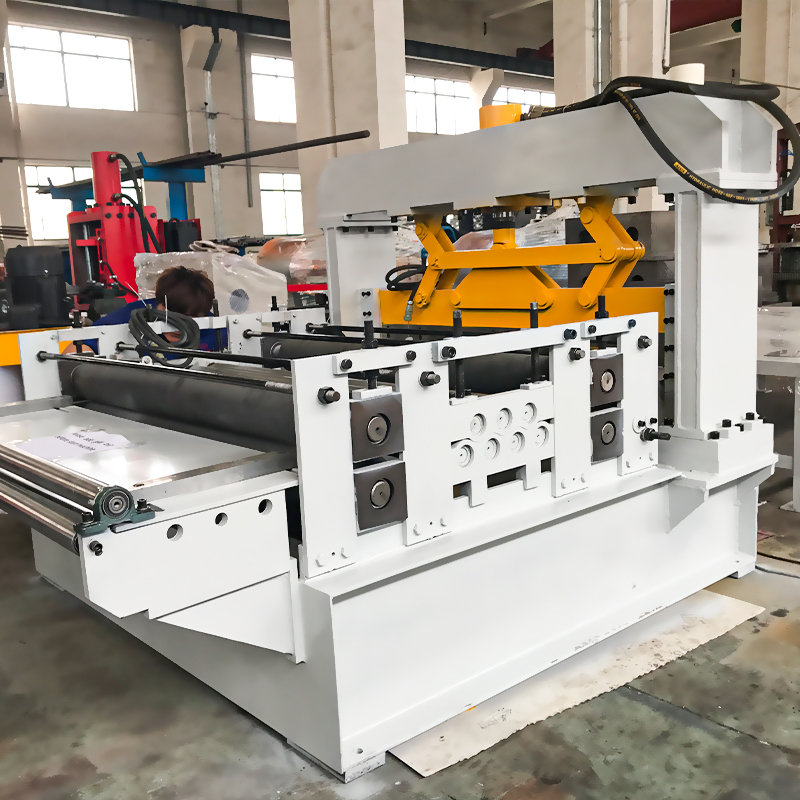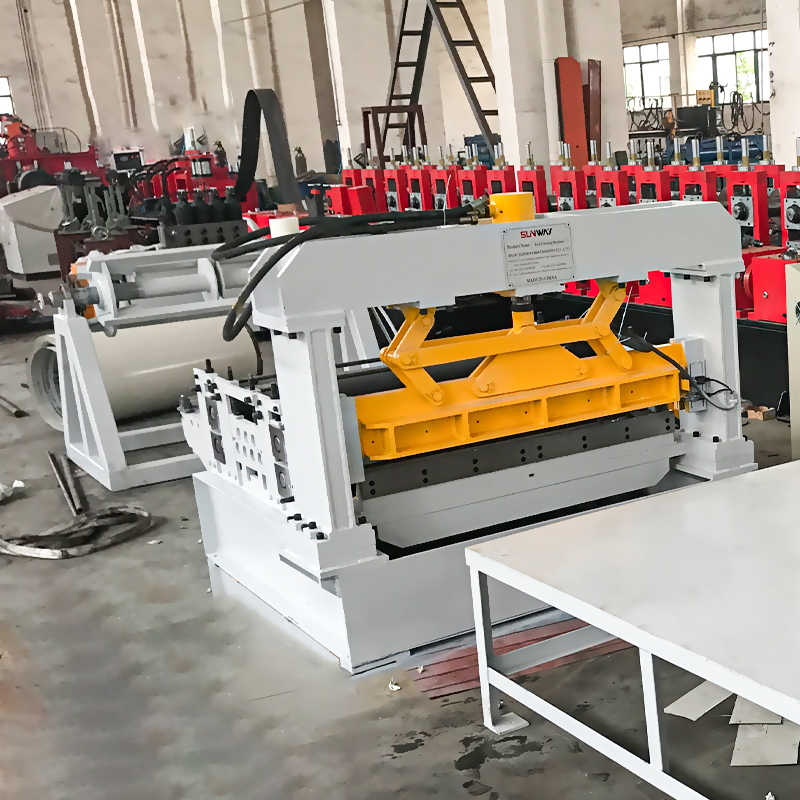ভূমিকা
ক proper lubrication system is essential for ensuring smooth, efficient, and long-lasting operation of roll forming machines. Lubrication reduces friction, prevents overheating, minimizes wear on dies and rollers, and improves product quality.
But how do you design an effective lubrication system for roll forming? What are the best lubricants, application methods, and maintenance practices?
In this guide, we’ll explore:
✅ The importance of lubrication in roll forming
✅ Types of lubrication systems used in roll forming machines
✅ Best lubricants for different materials
✅ Common lubrication problems & solutions
✅ How to maintain an efficient lubrication system
Let’s dive into the critical role of lubrication systems in roll forming and how to optimize them for maximum efficiency in 2025!
Why Lubrication is Critical in Roll Forming Machines
Roll forming involves continuous bending of metal sheets, which generates friction and heat. Without proper lubrication, this can lead to:
❌ Excessive roller wear and die damage
❌ Inconsistent profile dimensions due to material sticking
❌ Increased energy consumption due to higher resistance
❌ Poor product finish with surface defects and scratches
A well-designed lubrication system prevents these issues, ensuring:
✅ Smooth material flow and bending
✅ Extended lifespan of rollers and dies
✅ Reduced downtime and maintenance costs
✅ High-quality finished products
Pro Tip: A properly maintained lubrication system can extend roller and die life by 50%!
Types of Roll Forming Lubrication Systems
Different roll forming applications require various lubrication systems based on production speed, material type, and environmental factors. Below are the most common lubrication methods:
| Lubrication System Type | How It Works | Best For | Advantages |
|---|---|---|---|
| Manual Lubrication | Operators apply lubricant with brushes or spray bottles | Low-volume production | Simple, low-cost |
| Drip Lubrication System | Lubricant drips onto rollers and dies | Medium-speed production | Reduces waste, easy to maintain |
| Misting (Spray) Lubrication | Fine mist of lubricant is sprayed onto material | High-speed roll forming | Even distribution, minimal waste |
| Flood Lubrication System | Large volumes of lubricant are continuously applied | Heavy-duty applications | Maximum cooling and friction reduction |
| Automatic Roller Lubricators | Lubricant is precisely applied using rollers | Precision forming | Reduces overuse, improves efficiency |
Pro Tip: Misting lubrication systems are ideal for high-speed production, reducing lubricant waste by 30%!
Best Lubricants for Roll Forming Machines
Choosing the right lubricant depends on the material, forming speed, and product application. Below is a comparison of commonly used roll forming lubricants:
| Lubricant Type | Best For | Key Benefits | Drawbacks |
|---|---|---|---|
| Water-Based Lubricants | General roll forming | Environmentally friendly, easy to clean | May evaporate quickly |
| Oil-Based Lubricants | Heavy-duty applications | High lubrication efficiency, reduces die wear | Requires cleaning after forming |
| Synthetic Lubricants | High-speed roll forming | High performance, long-lasting | Higher cost |
| Dry Film Lubricants | Stainless steel forming | No residue, reduces friction | May require reapplication frequently |
Pro Tip: Synthetic lubricants offer superior performance and last longer, reducing downtime!

Common Lubrication Problems & How to Fix Them
Even with a properly designed lubrication system, issues can arise. Below are common lubrication problems and their solutions:
| Problem | Cause | Solution |
|---|---|---|
| Excessive Lubricant Buildup | Overuse of lubricant | Adjust application rate, use precision spray systems |
| Insufficient Lubrication | Clogged nozzles or incorrect lubricant type | Clean nozzles, switch to compatible lubricant |
| Roller Slipping | Too much lubricant on rollers | Optimize lubricant viscosity, reduce excess application |
| Material Sticking in Dies | Poor lubrication or wrong lubricant type | Use high-performance lubricants, increase application |
| Lubricant Contamination | Dust and debris mixing with lubricant | Install filtration systems, perform regular cleaning |
Pro Tip: Regular maintenance of lubrication nozzles and filters can prevent 80% of lubrication-related issues!
How to Maintain an Efficient Lubrication System
Proper lubrication system maintenance prevents breakdowns, reduces costs, and ensures smooth production. Follow these best practices to optimize lubrication performance:
1. Regularly Inspect Lubrication Lines & Nozzles
✅ Check for clogs, leaks, or uneven spray patterns.
✅ Clean nozzles to ensure even lubricant distribution.
2. Use the Correct Lubricant for Your Material
✅ Steel, aluminum, and stainless steel require different lubricants.
✅ Avoid mixing lubricants to prevent chemical reactions.
3. Monitor Lubricant Levels & Refill When Necessary
✅ Low lubricant levels cause increased friction and roller wear.
✅ Use automatic refill systems for continuous lubrication.
4. Install Filtration Systems for Clean Lubricant Flow
✅ Contaminated lubricant damages rollers and reduces efficiency.
✅ Use filtration systems to remove dust, debris, and metal particles.
5. Optimize Lubricant Application for Minimal Waste
✅ Overuse increases costs and creates messy workspaces.
✅ Use precision misting or roller lubrication systems to ensure controlled application.
Pro Tip: Proper lubrication maintenance can extend roller life by up to 3x!
Advanced Strategies for Optimizing Roll Forming Lubrication Systems
To maximize efficiency, reduce maintenance costs, and enhance product quality, manufacturers must implement advanced lubrication strategies tailored for roll forming machines. Below are the most effective techniques to improve lubrication performance and extend equipment lifespan.
1. Automated Lubrication Systems for Continuous Operation
- Smart lubrication systems use sensors to apply lubricant only when needed, reducing waste.
- Automated spray or roller lubrication ensures even distribution and minimizes manual intervention.
- Reduces downtime associated with manual lubrication.
2. AI-Powered Lubrication Monitoring
- AI-based monitoring systems analyze lubrication patterns and detect inconsistencies.
- These systems adjust lubricant flow in real-time to prevent roller wear and overheating.
- Helps in predictive maintenance, reducing unexpected failures.
3. Eco-Friendly & Biodegradable Lubricants
- Many industries are shifting to environmentally friendly lubricants that are non-toxic and biodegradable.
- Water-based synthetic lubricants reduce environmental impact while maintaining efficiency.
- Less residue buildup, leading to easier cleaning and lower maintenance costs.
Pro Tip: Automated lubrication systems can reduce lubricant consumption by up to 40%!
Optimizing Lubrication for Different Roll Forming Materials
দ্য best lubrication method depends on the type of material being formed. Below is a comparison of optimal lubrication strategies for different materials:
| Material | Best Lubrication Type | Application Method | Why It Works |
|---|---|---|---|
| Mild Steel | Oil-based or synthetic lubricants | Spray or roller lubrication | Prevents oxidation and die wear |
| Stainless Steel | Dry film or synthetic lubricants | Misting system | Reduces friction and prevents galling |
| Aluminum | Water-based lubricants | Drip or misting lubrication | Prevents material sticking to rollers |
| Galvanized Steel | Low-viscosity oil-based lubricants | Roller lubrication | Protects coating, reduces roller wear |
Pro Tip: Stainless steel roll forming requires dry film lubricants to prevent surface contamination!
How to Troubleshoot Lubrication System Failures
Even with a well-maintained lubrication system, problems can arise. Below are common lubrication system issues and how to fix them.
| Problem | Cause | Solution |
|---|---|---|
| Excess Lubricant on Material | Over-application of lubricant | Adjust flow rate, use precision spray nozzles |
| Rollers Not Getting Enough Lubrication | Clogged nozzles or low lubricant levels | Clean nozzles, refill lubricant reservoir |
| Uneven Lubrication Distribution | Misaligned spray system | Adjust nozzles for uniform coverage |
| Lubrication System Leaks | Loose fittings or damaged hoses | Inspect and replace worn-out parts |
| Lubricant Contamination | Dust, metal shavings mixing in lubricant | Install filtration systems to remove contaminants |
Pro Tip: Cleaning lubrication nozzles regularly can prevent 80% of lubrication failures!
How to Reduce Lubricant Waste & Improve Cost Efficiency
Lubricant waste increases operational costs and impacts sustainability. Here’s how to reduce lubricant waste while maintaining optimal machine performance.
1. Use Precision Application Methods
✅ Misting or spray systems apply just the right amount of lubricant.
✅ Roller lubrication ensures direct application to forming areas, reducing excess use.
2. Implement Real-Time Lubrication Monitoring
✅ IoT-enabled sensors track lubrication flow and detect overuse or underuse.
✅ AI-based predictive analytics adjust lubrication based on forming speed and material type.
3. Recycle & Reuse Lubricants Where Possible
✅ Install filtration systems to remove contaminants from used lubricant.
✅ Use high-efficiency lubricants that require less frequent reapplication.
Pro Tip: Precision lubrication can reduce lubricant costs by up to 30%!

Choosing the Right Lubrication Equipment for Roll Forming
দ্য right lubrication equipment ensures consistent application, minimal waste, and maximum efficiency. Below is a comparison of different lubrication equipment options.
| Lubrication Equipment | Best For | Key Benefit | Cost Efficiency |
|---|---|---|---|
| Manual Spray Lubrication | Low-volume production | Simple & low maintenance | 💲💲💲 |
| Automatic Misting System | High-speed forming | Even distribution, low waste | 💲💲💲💲 |
| Drip Lubrication System | Medium-speed production | Reduces waste, easy to maintain | 💲💲 |
| Roller Lubricators | Precision forming | Applies lubricant directly to rollers | 💲💲💲💲💲 |
| Flood Lubrication System | Heavy-duty forming | Maximum cooling & friction reduction | 💲💲💲💲 |
Pro Tip: Roller lubricators offer the best balance between efficiency and cost savings for high-precision applications!
FAQ: Roll Forming Lubrication Systems & Optimization
1. What is the best lubrication method for high-speed roll forming?
- Misting or spray lubrication systems are best for high-speed applications as they evenly distribute lubricant while minimizing waste.
2. How often should I replace lubricant filters?
- Lubricant filters should be replaced every 3-6 months to prevent contaminant buildup and system clogging.
3. Can I use the same lubricant for different metals?
- No! Different metals require different lubricants. For example:
- Aluminum needs water-based lubricants to prevent sticking.
- Stainless steel requires dry film lubricants to avoid contamination.
4. How do I prevent excess lubrication from affecting product quality?
- Use precision lubrication systems like roller lubricators or misting nozzles to apply only the necessary amount of lubricant.
5. Where can I buy high-quality lubrication systems for roll forming machines?
For custom-built roll forming lubrication systems, visit WUXI SUNWAY MACHINERY CO., LTD.
Final Thoughts
ক well-optimized lubrication system is crucial for reducing wear, improving efficiency, and ensuring high-quality roll forming production. By implementing automated lubrication, AI-powered monitoring, and eco-friendly lubricants, manufacturers can reduce maintenance costs, extend machine lifespan, and improve overall performance.
WUXI SUNWAY MACHINERY CO., LTD is a leading global manufacturer of custom-built roll forming machines and lubrication systems, offering advanced technology, expert support, and competitive pricing.
Want to optimize your roll forming lubrication system? Contact us today!
